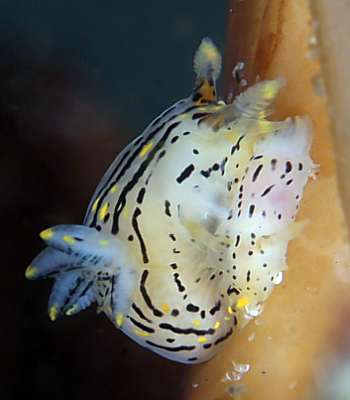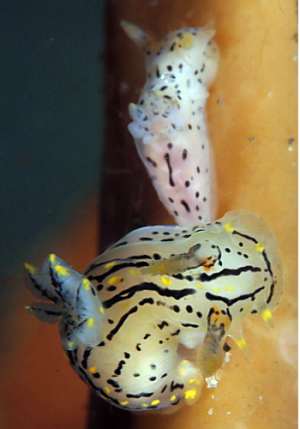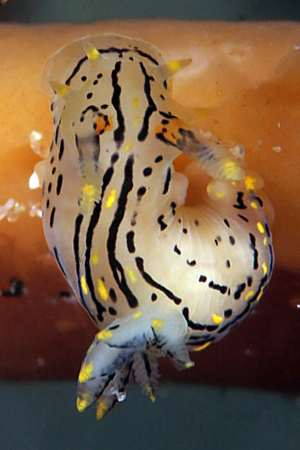Polycera atra - mating juveniles
June 11, 2005
From: Michael Jimenez

Hi Bill,
Here are a few images of Polycera atra in the juvenile stage. The first shot is of a a 3mm long juvenile mating with another juvenile (looks younger) that's 2mm long. The slugs were so small that I didn't realize what was going on until I reviewed the pictures on my computer! There was an abundance of these juveniles at San Carlos beach in Monterey during our night dive. It was the first time that I've seen this slug.
Locality: Monterey, California, USA. Depth: 15 feet. Length: 3 mm & 2 mm. 08 June 2005. sandy bottom with clusters of kelp and algae. Photographer: Michael Jimenez
Mike
mpj17@pacbell.net


Dear Mike,
Even for California I must say I think mating at 2 mm is a bit extreme. It does however illustrate how the reproductive system develops in these animals. I have no personal knowledge of this species but often when dissecting juvenile nudibranchs we will find that at a very early stage, even before gonads are visible, there will be a little tangled mass of ducts, which represent the primordial 'plumbing' of the reproductive system. At this stage the associated glands have not developed. Usually the first part of the reproductive sytem to develop in these hermaphrodite animals are the male organs - the testis and penis - and often in half developed animals sperm from another partner will be found packed in a sperm sac, suggesting that animals can exchange sperm before they have mature eggs to fertilise. I don't think we know whether they can keep the sperm alive and functional until their own eggs mature, but if so, it would be a useful survival strategy. In many cases, it is the juveniles which are found in large aggregations - often hatching together, or settling together from a larval swarm. Many will die before maturity, so if they can exchange sperm at this early stage, and store it for some time, it is not so critical if only a few survive to maturity, or if as adults they have difficulty in finding a partner. It is a very interesting observation.
Best wishes,
Bill Rudman
Related messages
-
Re: Polycera atra from California
From: Wesley M.Farmer, July 1, 2008 -
Polycera atra from California
From: Clinton Bauder, November 5, 2007 -
Polycera atra - feeding juveniles
From: Bruce Wight, August 3, 2007 -
Polycera atra from California
From: Chris Grossman, July 12, 2004 -
Polycera atra(?) from California
From: Daniel Geiger, September 20, 2002 -
Re: Polycera atra(?) from California
From: Dave Behrens, September 20, 2002 -
Photos of Polycera atra
From: Bruce Wight, July 7, 2000 -
Polycera atra? juvenile
From: Bruce Wight, July 5, 2000
